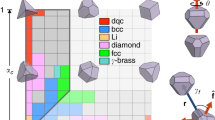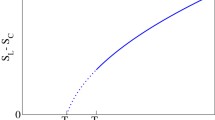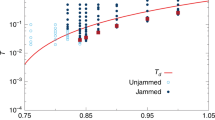Abstract
We show that the standard Fermi–Pasta–Ulam system, with a suitable choice for the interparticle potential, constitutes a model for glasses, and indeed an extremely simple and manageable one. Indeed, it allows one to describe the landscape of the minima of the potential energy and to deal concretely with any one of them, determining the spectrum of frequencies and the normal modes. A relevant role is played by the harmonic energy \(\mathcal {E}\) relative to a given minimum, i.e., the expansion of the Hamiltonian about the minimum up to second order. Indeed we find that there exists an energy threshold in \(\mathcal {E}\) such that below it the harmonic energy \(\mathcal {E}\) appears to be an approximate integral of motion for the whole observation time. Consequently, the system remains trapped near the minimum, in what may be called a vitreous or glassy state. Instead, for larger values of \(\mathcal {E}\) the system rather quickly relaxes to a final equilibrium state. Moreover we find that the vitreous states present peculiar statistical behaviors, still involving the harmonic energy \(\mathcal {E}\). Indeed, the vitreous states are described by a Gibbs distribution with an effective Hamiltonian close to \(\mathcal {E}\) and with a suitable effective inverse temperature. The final equilibrium state presents instead statistical properties which are in very good agreement with the Gibbs distribution relative to the full Hamiltonian of the system.
Similar content being viewed by others
References
Fucito, R., Marchesoni, F., Marinari, E., Parisi, G., Peliti, L., Ruffo, S., Vulpiani, A.: Approach to equilibrium in a chain of nonlinear oscillators. J. Phys. 43, 707 (1982)
Parisi, G.: On the approach to equilibrium of a Hamiltonian chain of anharmonic oscillators. Europhys. Lett. 40, 357 (1997)
Fermi, E., Pasta, J., Ulam, S.: Studies of nonlinear problems. In: Fermi, E. (ed.) Collected Papers, vol. II, no. 266, p. 977. Accademia Nazionale dei Lincei and The University of Chicago Press, Chicago (1965)
Goldstein, M.: Viscous liquids and the glass transition: a potential energy barrier picture. J. Chem. Phys. 51, 3728 (1969)
Grigera, T.S., Cavagna, A., Giardina, I., Parisi, G.: Geometric approach to the dynamic glass transition. Phys. Rev. Lett. 88, 055502 (2002)
Frenkel, J.: Kinetic theory of liquids. Oxford C.P., Oxford (1946)
Carmona, R., Klein, A., Martinelli, F.: Anderson localization for Bernoulli and other singular potentials. Commun. Mat. Phys. 108, 41 (1987)
Benettin, G., Carati, A., Galgani, L., Giorgilli, A.: The Fermi–Pasta–Ulam problem and the metastability perspective. In: Gallavotti, G. (ed.) The Fermi-Pasta-Ulam Problem: A Status Report, Lecture Notes in Physics, p 728. Springer, Berlin (2007)
Benettin, G., Ponno, A.: Time scales to equipartition in the Fermi–Pasta–Ulam problem: finite size effects and thermodynamic limit. J. Stat. Phys. 144, 793 (2011)
Maiocchi, A., Bambusi, D., Carati, A.: An averaging theorem for Fermi–Pasta–Ulam in the thermodynamic limit. J. Stat. Phys. 155, 300 (2014)
Lord, R.C., Morrow, J.C.: Calculation of the heat capacity of α–quartz and vitreous silica from spectroscopic data. J. Chem. Phys. 26, 230 (1957)
Author information
Authors and Affiliations
Corresponding author
Rights and permissions
About this article
Cite this article
Carati, A., Maiocchi, A., Galgani, L. et al. The Fermi–Pasta–Ulam System as a Model for Glasses. Math Phys Anal Geom 18, 31 (2015). https://doi.org/10.1007/s11040-015-9201-x
Received:
Accepted:
Published:
DOI: https://doi.org/10.1007/s11040-015-9201-x




